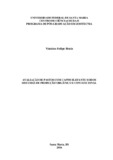| dc.creator | Bratz, Vinicius Felipe | |
| dc.date.accessioned | 2016-08-03 | |
| dc.date.available | 2016-08-03 | |
| dc.date.issued | 2016-02-18 | |
| dc.identifier.citation | BRATZ, Vinicius Felipe. EVALUATION WITH ELEPHANT GRASS PASTURES UNDER THE ORGANIC AND CONVENTIONAL PRODUCTION SYSTEMS. 2016. 57 f. Dissertação (Mestrado em Zootecnia) - Universidade Federal de Santa Maria, Santa Maria, 2016. | por |
| dc.identifier.uri | http://repositorio.ufsm.br/handle/1/10901 | |
| dc.description.abstract | The objective of this research was to evaluate the forage production, stocking rate and nutritive value of elephant grass in organic and conventional systems. In the organic system, were combined species with complementary growth periods; the elephant grass was planted in rows 3 m apart from each other; between rows of elephant grass, the annual ryegrass was seeding in the cool season and the development of spontaneous growing species in the warm season. In the conventional production two pastures were studied, one with the same strategy of organic production but with mineral fertilization, and the other elephant grass was cultivated alone. It was applied 120 kg of N ha-1 with mineral and organic fertilizer (manure of cattle and pig slurry) in the conventional and organic systems, respectively. Lactating Holstein cows were used in the evaluation. The experimental design was completely randomized with three treatments (grazing systems), three replicates (paddocks) with repeated measures (grazing cycles). The pre and post forage mass parameters, botanical and structural composition, forage production and stocking rate were evaluated. Forage samples were collected by the hand-plucking method to determine the organic matter, mineral matter, crude protein, neutral detergent fiber, in situ organic matter digestibility. During the experimental period (370 days), nine grazing cycles were performed in organic and conventional systems (elephant grass in association of other plants) and eight grazing cycles in the conventional system (elephant grass alone). Forage production, stocking rate and crude protein of elephant grass were 31.9; 32.6; 24.2 t of dry matter ha-1; 3.4; 2.1; 4.6 animal units ha-1 and 16.6; 14.9; 13.6 %, respectively for the grazing systems. Considering the herbage yield, better performance were foud on mixture pastures. Higher values of crude protein were observed in the organic system. | eng |
| dc.description.sponsorship | Coordenação de Aperfeiçoamento de Pessoal de Nível Superior | |
| dc.format | application/pdf | por |
| dc.language | por | por |
| dc.publisher | Universidade Federal de Santa Maria | por |
| dc.rights | Acesso Aberto | por |
| dc.subject | Pastejo rotacionado | por |
| dc.subject | Produção de forragem | por |
| dc.subject | Vacas leiteiras | por |
| dc.subject | Valor nutritivo | por |
| dc.subject | Rotational grazing | eng |
| dc.subject | Forage production | eng |
| dc.subject | Lactating cows | eng |
| dc.subject | Nutritive value | eng |
| dc.title | Avaliação de pastos com capim elefante sob os sistemas de produção orgânico e convencional | por |
| dc.title.alternative | Evaluation with elephant grass pastures under the organic and conventional production systems | eng |
| dc.type | Dissertação | por |
| dc.description.resumo | Objetivou-se com esta pesquisa avaliar a produção de forragem, taxa de lotação e valor nutritivo do capim elefante nos sistemas orgânico e convencional. No sistema orgânico, combinaram-se espécies com períodos de crescimento complementares; o capim elefante foi plantado em linhas com 3 m de distância uma da outra; entre as fileiras de capim elefante, durante o período hibernal, foi semeado o azevém e no período estival permitiu-se o desenvolvimento de espécies de crescimento espontâneo. Na produção convencional foram estudadas duas pastagens, uma com a mesma estratégia da produção orgânica, porém com adubação mineral e outra de capim elefante sob cultivo estreme. Foram aplicados 120 kg de N ha-1 com adubação mineral e orgânica (esterco bovino e dejetos de suínos) nos sistemas convencional e orgânico, respectivamente. Vacas da raça Holandesa foram utilizadas na avaliação. O delineamento experimental foi o inteiramente casualizado, com três tratamentos (sistemas forrageiros), três repetições (piquetes) com medidas repetidas no tempo (ciclos de pastejo). Foram avaliados parâmetros de massa de forragem de pré e pós pastejo, composições botânica e estrutural, produção de forragem e taxa de lotação. Foram coletadas amostras de forragem por simulação de pastejo para a determinação da matéria orgânica, matéria mineral, proteína bruta, fibra em detergente neutro e digestibilidade in situ da matéria orgânica. Durante o período experimental (370 dias) foram efetuados nove ciclos de pastejo nos sistemas orgânico e convencional (capim elefante em associação com outras plantas) e oito ciclos de pastejo no sistema convencional (capim elefante em cultivo singular). A produção de forragem, a taxa de lotação e o teor de proteína foram de 31,9; 32,3; 24,2 t de matéria seca ha-1; 3,4; 2,1 e 4,6 unidades animais ha-1 e 16,6; 14,9; 13,6 %, respectivamente para os sistemas forrageiros. Considerando a produção de forragem, pastos com misturas forrageiras apresentaram melhor desempenho. Foram observados maiores valores de proteína bruta no sistema orgânico. | por |
| dc.contributor.advisor1 | Olivo, Clair Jorge | |
| dc.contributor.advisor1Lattes | http://buscatextual.cnpq.br/buscatextual/visualizacv.do?id=K4783027J6 | por |
| dc.contributor.referee1 | Pötter, Luciana | |
| dc.contributor.referee1Lattes | http://buscatextual.cnpq.br/buscatextual/visualizacv.do?id=K4796005T7 | por |
| dc.contributor.referee2 | Meinerz, Gilmar Roberto | |
| dc.contributor.referee2Lattes | http://buscatextual.cnpq.br/buscatextual/visualizacv.do?id=K4588351P8 | por |
| dc.creator.Lattes | http://lattes.cnpq.br/1003789312269735 | por |
| dc.publisher.country | BR | por |
| dc.publisher.department | Zootecnia | por |
| dc.publisher.initials | UFSM | por |
| dc.publisher.program | Programa de Pós-Graduação em Zootecnia | por |
| dc.subject.cnpq | CNPQ::CIENCIAS AGRARIAS::ZOOTECNIA | por |


